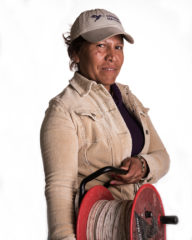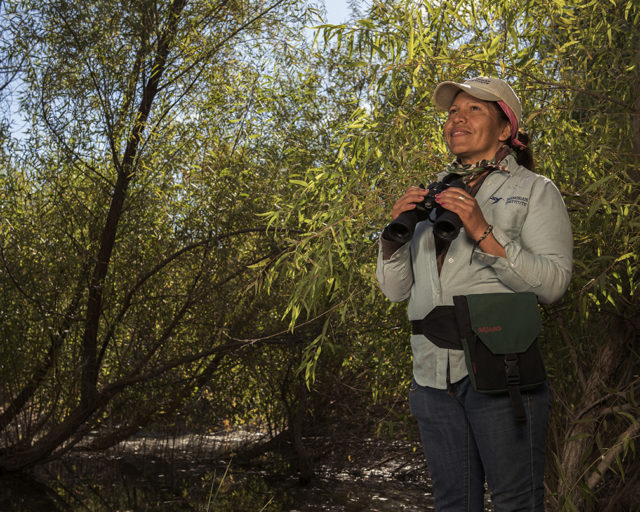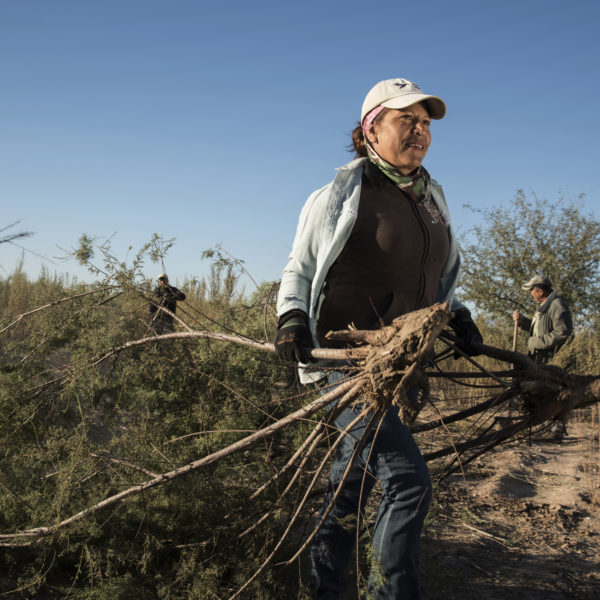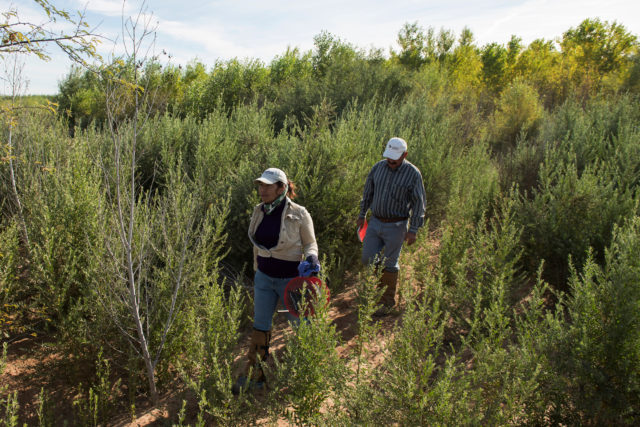
“Our beloved colleague,” is what her Sonoran Institute Colorado River Delta Program co-workers call her, and after getting to know Celedonia (Celia) Alvarado Camacho and her story, it’s easy to see why.
Orphaned at age four, Celia was raised by her grandparents in rural Rio Verde, San Luis Potosi, about 200 miles north of Mexico City. Growing up in the shadow of mountain ranges, in an area thick with oaks and poplar and alive with birdsong, Celia enjoyed climbing trees to peek at baby birds in their nests. “I was very careful to avoid mistreating them,” she says. “I’ve felt a duty to protect nature since I was a little girl.”
She loved watching the flight of eagles and hawks and dreamed of soaring high in the sky, but Celia’s expectations for the future were much more down to earth. In her family, husbands were the ones who worked and had careers, and her grandparents could only provide her with an elementary-school education. For most of her adult life, she was a homemaker, raising four children. Then her husband died, and her life changed. With three children still at home to support, Celia found work in the Mexicali Valley’s vegetable fields, cutting and cleaning parsley and cilantro. One day, a woman in her village told her about a temporary job for the offseason, working with the Sonoran Institute in the Colorado River area. It was the start of Celia’s new career and new life.

In this job, Celia never stops learning. With every new tree species and growing technique, with every new bird sighting, with each tour she leads, she grows as well.
As she helped clear invasive vegetation, plant native trees, and install irrigation systems, Celia asked a fellow worker why they were doing this work. He told her it was because the river was dry, that there used to be water but now there was almost none and therefore all the vegetation was disappearing. Helping native trees grow would be good for the animals and birds, he said. He also told her that Sonoran Institute would teach her about birds, and that one day she would go birding.
“Something moved inside of me,” Celia says. “Growing up in the country, I was able to enjoy the outdoors. But for most of my adult life, I had been locked indoors, raising children, oblivious to everything that happened around me. Now I had the opportunity to be in nature, and I felt that joy I had as a child. The river is my second home.”
As a child, she was confident in her ability to learn, but by the time she started her job with Sonoran Institute, she worried that she was too old and was self-conscious about her lack of education. “But I took a chance,” she says. “Through a lot of training, practice, and workshops, I was able to achieve it. I thank both Sonoran Institute and [conservation partner] Pronatura, because they taught me and gave me the time I needed to go to the workshops. I appreciate this knowledge a lot. It is so beautiful.”
When the temporary work ended, Sonoran Institute offered Celia a permanent job doing the same kind of work. Ten years later, Celia is a leader on the Delta team, now supervisor of tree planting and production. There since the beginning of the Laguna Grande restoration project, it is fair to say she has had a hand in planting more than 200,000 trees.
“Growing trees is like raising a baby,” Celia says. “Cutting a small stick, taking care of it until he grows, selecting the soil, putting on the root enhancer, irrigating it properly. And when you see it sprouting, you think of it as your son. Seeing the results is one of the things I like the most and that I truly value.”
“Do you sing to the trees?” Francisco Zamora Arroyo, director of Sonoran Institute’s Colorado River Delta Program, asks her.
“Yes, I sing to them!” Celia laughs. “I pamper them and protect them.”
While Celia sings to her trees, birds sing to her. And, thanks to the workshops and training she has received, she knows their calls, colors, and habits. She is a member of the local birding group, Alas del Delta, and guides school trips, family groups, and international tourists on birding tours.
“When I’m in the tree nursery, I’ll say to my colleague Guadalupe, ‘The northern flicker woodpeckers are almost here,’ or ‘We’re in autumn, so the yellow-rumped warblers are coming.’ Or, ‘Hey, it’s already the time when the birds of prey start arriving, so soon we’ll begin to see hawks.’ When I’m in the field, I’ll hear their songs and will record the dates they start arriving.”
In this job, Celia never stops learning. With every new tree species and growing technique, with every new bird sighting, with each tour she leads, she grows as well. Over the past 10 years, Celia has seen the “babies” she nurtured become a forest of tall, beautiful trees. She has watched the birds return. She has delighted in seeing the coyotes, beaver, skunks, and roadrunners that have reappeared because of the reforestation she has helped lead. She is no longer frightened of the rattlesnakes that sometimes glide between her feet while she works or of not knowing all the right English words when she leads a tour. She’s gratified by the growing awareness in her community of the importance of the restoration work—the recognition that it provides good jobs, is a nice place to visit with the family, and is worthy of care. Above all, she feels a deep connection to the river and all its creatures.
“Animals know they can take refuge and find their food here now,” she says. “They can’t talk, but they look, and they do see this change. And when they look at me, I dream that they are saying, ‘Hey, this is nice.’”
“I dream a lot, right?” Celia laughs.
Read more about Celia’s work and restoration successes at Laguna Grande


